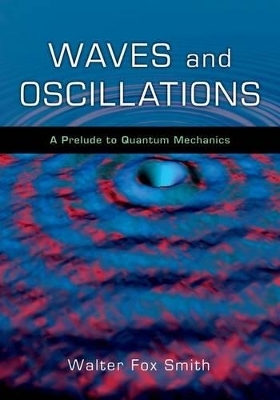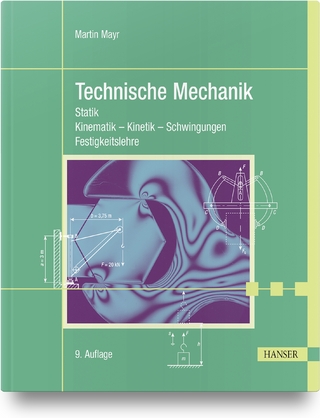
Waves and Oscillations
Oxford University Press Inc (Verlag)
978-0-19-539349-1 (ISBN)
Waves and oscillations permeate virtually every field of current physics research, are central to chemistry, and are essential to much of engineering. Furthermore, the concepts and mathematical techniques used for serious study of waves and oscillations form the foundation for quantum mechanics. Once they have mastered these ideas in a classical context, students will be ready to focus on the challenging concepts of quantum mechanics when they encounter them, rather than struggling with techniques.
This lively textbook gives a thorough grounding in complex exponentials and the key aspects of differential equations and matrix math; no prior experience is assumed. The parallels between normal mode analysis, orthogonal function analysis (especially Fourier analysis), and superpositions of quantum states are clearly drawn, without actually getting into the quantum mechanics. An in-depth, accessible introduction to Hilbert space and bra-ket notation begins in Chapter 5 (on symmetrical coupled oscillators), emphasizing the analogy with conventional dot products, and continues in subsequent chapters.
Connections to current physics research (atomic force microscopy, chaos, supersolids, micro electro-mechanical systems (MEMS), magnetic resonance imaging, carbon nanotubes, and more) are highlighted in the text and in end-of-chapter problems, and are frequently updated in the associated website.
The book actively engages readers with a refreshing writing style and a set of carefully applied learning tools, such as in-text concept tests, ÿour turn¨ boxes (in which the student fills in one or two steps of a derivation), concept and skill inventories for each chapter, and ¨wrong way¨ problems in which the student explains the flaw in a line of reasoning. These tools promote self-awareness of the learning process.
The associated website features custom-developed applets, video and audio recordings, additional problems, and links to related current research. The instructor-only part includes difficulty ratings for problems, optional hints, full solutions, and additional support materials.
Walter Fox Smith combines his passions for teaching and nanophysics research at Haverford College. His research centers on the photoelectronic properties of self-assembling molecular electronics. He is also known as "the singing physics professor", thanks to his compositions and performances in the classroom and at social gatherings of physicists.
LEARNING TOOLS USED IN THIS BOOK; 1.1 SINUSOIDAL OSCILLATIONS ARE EVERYWHERE; 1.2 THE PHYSICS AND MATHEMATICS BEHIND SIMPLE HARMONIC MOTION; 1.3 IMPORTANT PARAMETERS AND ADJUSTABLE CONSTANT OF SIMPLE HARMONIC MOTION; 1.4 MASS ON A SPRING; 1.5 ELECTRICAL OSCILLATORS; 1.6 REVIEW OF TAYLOR SERIES APPROXIMATIONS; 1.7 EULER'S EQUATION; 1.8 REVIEW OF COMPLEX NUMBERS; 1.9 COMPLEX EXPONENTIAL NOTATION FOR OSCILLATORY MOTION; 1.10 THE COMPLEX REPRESENTATION FOR AC CIRCUITS; 1.11 ANOTHER IMPORTANT COMPLEX FUNCTION: THE QUANTUM MECHANICAL WAVEFUNCTION; 1.12 PURE SINUSOIDAL OSCILLATIONS AND UNCERTAINTY PRINCIPLES; CONCEPT AND SKILL INVENTORY; PROBLEMS; 2.1 REQUIREMENTS FOR HARMONIC OSCILLATION; 2.2 PENDULUMS; 2.3 ELASTIC DEFORMATIONS AND YOUNG'S MODULUS; 2.4 SHEAR; 2.5 TORSION AND TORSIONAL OSCILLATORS; 2.6 BENDING AND CANTILEVERS; CONCEPT AND SKILL INVENTORY; PROBLEMS; 3.1 DAMPED MECHANICAL OSCILLATORS; 3.2 DAMPED ELECTRICAL OSCILLATORS; 3.3 EXPONENTIAL DECAY OF ENERGY; 3.4 THE QUALITY FACTOR; 3.5 UNDERDAMPED, OVERDAMPED, AND CRITICALLY DAMPED BEHAVIOR; 3.6 TYPES OF DAMPING; CONCEPT AND SKILL INVENTORY; PROBLEMS; 4.1 RESONANCE; 4.2 EFFECTS OF DAMPING; 4.3 ENERGY FLOW; 4.4 LINEAR DIFFERENTIAL EQUATIONS, THE SUPERPOSITION PRINCIPLE FOR DRIVEN SYSTEMS, AND THE RESPONSE TO MULTIPLE DRIVE FORCES; 4.5 TRANSIENTS; 4.6 ELECTRICAL RESONANCE; 4.7 OTHER EXAMPLES OF RESONANCE: MRI AND OTHER SPECTROSCOPIES; 4.8 NON-LINEAR OSCILLATORS AND CHAOS; CONCEPT AND SKILL INVENTORY; PROBLEMS; 5.1 BEATS: AN ASIDE?; 5.2 TWO SYMMETRIC COUPLED OSCILLATORS: EQUATIONS OF MOTION; 5.3 NORMAL MODES; 5.4 SUPERPOSING NORMAL MODES; 5.5 NORMAL MODE ANALYSIS, AND NORMAL MODES AS AN ALTERNATE DESCRIPTION OF REALITY; 5.6 HILBERT SPACE AND BRA-KET NOTATION; 5.7 THE ANALOGY BETWEEN COUPLED OSCILLATORS AND MOLECULAR ENERGY LEVELS; 5.8 NON-ZERO INITIAL VELOCITIES; 5.9 DAMPED, DRIVEN COUPLED OSCILLATORS; CONCEPT AND SKILL INVENTORY; PROBLEMS; 6.1 MATRIX MATH; 6.2 EQUATIONS OF MOTION AND THE EIGENVALUE EQUATION; 6.3 PROCEDURE FOR SOLVING THE EIGENVALUE EQUATION; 6.4 SYSTEMS WITH MORE THAN TWO OBJECTS; 6.5 NORMAL MODE ANALYSIS FOR MULIT-OBJECT, ASYMMETRICAL SYSTEMS; 6.6 MORE MATRIX MATH; 6.7 ORTHOGONALITY OF NORMAL MODES, NORMAL MODE COORDINATES, DEGENERACY, AND SCALING OF HILBERT SPACE FOR UNEQUAL MASSES; CONCEPT AND SKILL INVENTORY; PROBLEMS; 7.1 THE BEADED STRING; 7.2 STANDING WAVE GUESS: BOUNDARY CONDITIONS QUANTIZE THE ALLOWED FREQUENCIES; 7.3 THE HIGHEST POSSIBLE FREQUENCY; CONNECTION TO WAVES IN A CRYSTALLINE SOLID; 7.4 NORMAL MODE ANALYSIS FOR THE BEADED STRING; 7.5 LONGITUDINAL OSCILLATIONS; 7.6 THE CONTINUOUS STRING; 7.7 NORMAL MODE ANALYSIS FOR CONTINUOUS SYSTEMS; 7.8 K-SPACE; CONCEPT AND SKILL INVENTORY; PROBLEMS; 8.1 INTRODUCTION; 8.2 THE FOURIER EXPANSION; 8.3 EXPANSIONS USING NON-NORMALIZED ORTHOGONAL BASIS FUNCTIONS; 8.4 FINDING THE COEFFICIENTS IN THE FOURIER EXPANSION; 8.5 FOURIER TRANSFORMS AND THE MEANING OF NEGATIVE FREQUENCY; 8.6 THE DISCRETE FOURIER TRANSFORM (DFT); 8.7 SOME APPLICATIONS OF FOURIER ANALYSIS; CONCEPT AND SKILL INVENTORY; PROBLEMS; 9.1 INTRODUCTION; 9.2 THE WAVE EQUATION; 9.3 TRAVELING SINUSOIDAL WAVES; 9.4 THE SUPERPOSITION PRINCIPLE FOR TRAVELING WAVES; 9.5 ELECTROMAGNETIC WAVES IN VACUUM; 9.6 ELECTROMAGNETIC WAVES IN MATTER; 9.7 WAVES ON TRANSMISSION LINES; 9.8 SOUND WAVES; 9.9 MUSICAL INSTRUMENTS BASED ON TUBES; 9.10 POWER CARRIED BY ROPE AND ELECTROMAGNETIC WAVES; RMS AMPLITUDES; 9.11 INTENSITY OF SOUND WAVES; DECIBELS; 9.12 DISPERSION RELATIONS AND GROUP VELOCITY; CONCEPT AND SKILL INVENTORY; PROBLEMS; 10.1 REFLECTIONS AND THE IDEA OF BOUNDARY CONDITIONS; 10.2 TRANSMITTED WAVES; 10.3 CHARACTERISTIC IMPEDANCES FOR MECHANICAL SYSTEMS; 10.4 "UNIVERSAL" EXPRESSIONS FOR TRANSMISSION AND REFLECTION; 10.5 REFLECTED AND TRANSMITTED WAVES FOR TRANSMISSION LINES; 10.6 REFLECTION AND TRANSMISSION FOR ELECTROMAGNETIC WAVES IN MATTER: NORMAL INCIDENCE; 10.7 REFLECTION AND TRANSMISSION FOR SOUND WAVES, AND SUMMARY OF ISOMORPHISMS; 10.8 SNELL'S LAW; 10.9 TOTAL INTERNAL REFLECTION AND EVANESCENT WAVES; CONCEPT AND SKILL INVENTORY; PROBLEMS; APPENDIX A: GROUP VELOCITY FOR AN ARBITRARY ENVELOPE FUNCTION; INDEX
| Erscheint lt. Verlag | 10.6.2010 |
|---|---|
| Zusatzinfo | 163 line drawings & 18 haltones |
| Verlagsort | New York |
| Sprache | englisch |
| Maße | 183 x 254 mm |
| Gewicht | 907 g |
| Themenwelt | Naturwissenschaften ► Physik / Astronomie ► Mechanik |
| Naturwissenschaften ► Physik / Astronomie ► Quantenphysik | |
| ISBN-10 | 0-19-539349-X / 019539349X |
| ISBN-13 | 978-0-19-539349-1 / 9780195393491 |
| Zustand | Neuware |
| Haben Sie eine Frage zum Produkt? |
aus dem Bereich


